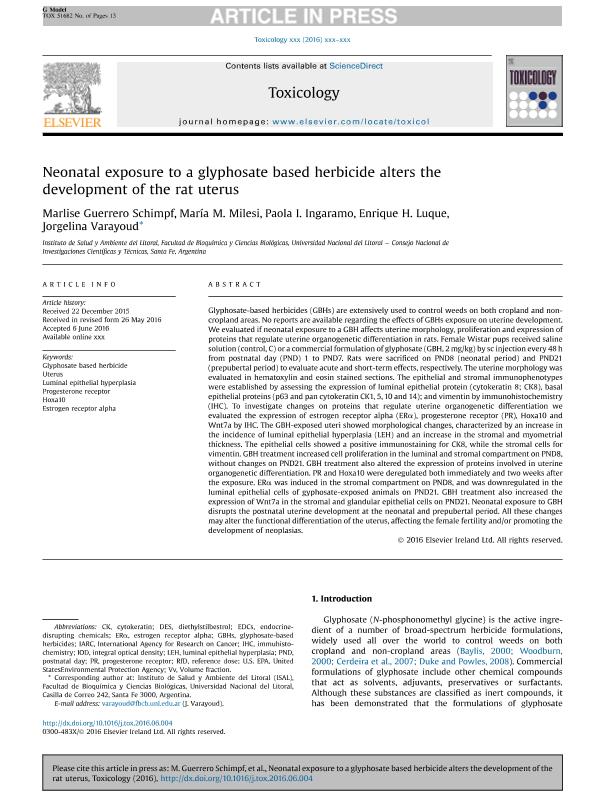Artículo
Neonatal exposure to a glyphosate based herbicide alters the development of the rat uterus
Guerrero Schimpf, Marlise Luciana ; Milesi, Maria Mercedes
; Milesi, Maria Mercedes ; Ingaramo, Paola Inés
; Ingaramo, Paola Inés ; Luque, Enrique Hugo
; Luque, Enrique Hugo ; Varayoud, Jorgelina Guadalupe
; Varayoud, Jorgelina Guadalupe
 ; Milesi, Maria Mercedes
; Milesi, Maria Mercedes ; Ingaramo, Paola Inés
; Ingaramo, Paola Inés ; Luque, Enrique Hugo
; Luque, Enrique Hugo ; Varayoud, Jorgelina Guadalupe
; Varayoud, Jorgelina Guadalupe
Fecha de publicación:
02/2017
Editorial:
Elsevier Ireland
Revista:
Toxicology
ISSN:
0300-483X
Idioma:
Inglés
Tipo de recurso:
Artículo publicado
Clasificación temática:
Resumen
Glyphosate-based herbicides (GBHs) are extensively used to control weeds on both cropland and non-cropland areas. No reports are available regarding the effects of GBHs exposure on uterine development. We evaluated if neonatal exposure to a GBH affects uterine morphology, proliferation and expression of proteins that regulate uterine organogenetic differentiation in rats. Female Wistar pups received saline solution (control, C) or a commercial formulation of glyphosate (GBH, 2 mg/kg) by sc injection every 48 h from postnatal day (PND) 1 to PND7. Rats were sacrificed on PND8 (neonatal period) and PND21 (prepubertal period) to evaluate acute and short-term effects, respectively. The uterine morphology was evaluated in hematoxylin and eosin stained sections. The epithelial and stromal immunophenotypes were established by assessing the expression of luminal epithelial protein (cytokeratin 8; CK8), basal epithelial proteins (p63 and pan cytokeratin CK1, 5, 10 and 14); and vimentin by immunohistochemistry (IHC). To investigate changes on proteins that regulate uterine organogenetic differentiation we evaluated the expression of estrogen receptor alpha (ERα), progesterone receptor (PR), Hoxa10 and Wnt7a by IHC. The GBH-exposed uteri showed morphological changes, characterized by an increase in the incidence of luminal epithelial hyperplasia (LEH) and an increase in the stromal and myometrial thickness. The epithelial cells showed a positive immunostaining for CK8, while the stromal cells for vimentin. GBH treatment increased cell proliferation in the luminal and stromal compartment on PND8, without changes on PND21. GBH treatment also altered the expression of proteins involved in uterine organogenetic differentiation. PR and Hoxa10 were deregulated both immediately and two weeks after the exposure. ERα was induced in the stromal compartment on PND8, and was downregulated in the luminal epithelial cells of gyphosate-exposed animals on PND21. GBH treatment also increased the expression of Wnt7a in the stromal and glandular epithelial cells on PND21. Neonatal exposure to GBH disrupts the postnatal uterine development at the neonatal and prepubertal period. All these changes may alter the functional differentiation of the uterus, affecting the female fertility and/or promoting the development of neoplasias.
Archivos asociados
Licencia
Identificadores
Colecciones
Articulos(ISAL)
Articulos de INSTITUTO DE SALUD Y AMBIENTE DEL LITORAL
Articulos de INSTITUTO DE SALUD Y AMBIENTE DEL LITORAL
Citación
Guerrero Schimpf, Marlise Luciana; Milesi, Maria Mercedes; Ingaramo, Paola Inés; Luque, Enrique Hugo; Varayoud, Jorgelina Guadalupe; Neonatal exposure to a glyphosate based herbicide alters the development of the rat uterus; Elsevier Ireland; Toxicology; 376; 2-2017; 2-14
Compartir
Altmétricas



